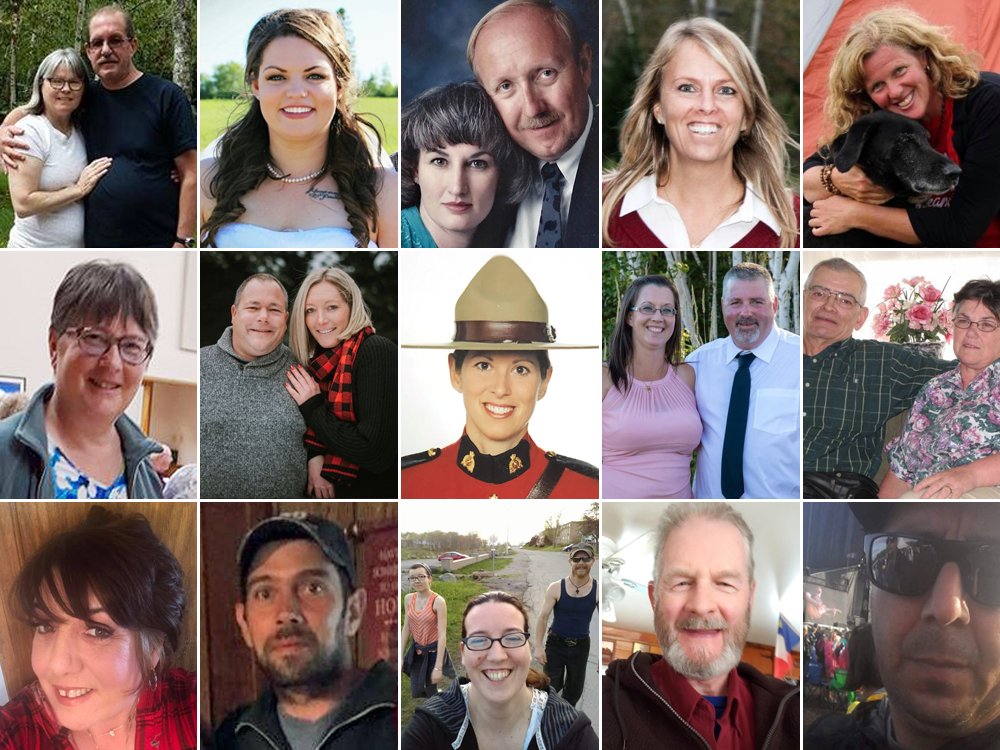Domestic Violence as Contagion
In Nova Scotia, reporting on the massacre of twenty-two people revealed that the attacks started with the violent assault of the killer’s girlfriend. Even after that critical information was released, the connection between the mass killing and domestic violence is not being made clearly and consistently. The story of a madman who kills without reason, a normally good guy with mental health issues, killing in a pastoral rural setting where no one expects violence, is being repeated in the media over and over. And then the news cycle moves on. If we can’t name the problem and how common it is in all communities, we are never going to find a cure.

Photo credit: National Post:
https://nationalpost.com/news/canada/nova-scotia-mass-shooting-victims
Misogyny – the hatred of women, is the infection that spreads. When misogyny is crossed with white supremacy, killers believe they are entitled to an elevated status in society, which includes access to the women they desire, because they are male and white. Most mass shooters are white males. Many have a history of domestic violence. Many attempt to enter the military or police. They are drawn to having authority and using force. These men are not exceptions or outliers. They are a distinct social group that some experts want to include on watch lists of domestic terrorists. The risk to public safety becomes visible when their need for control over others rises to the surface. There are always warning signs that get missed. As a society, we wait for violence to occur before we acknowledge that a person is dangerous.
In the case of the Nova Scotia killer, a variety of media reports detail warning signs of severe domestic assault that overlap and intersect with warning signs of more generalized violence that occurred over many years. There was an assault in 2001. Wortman’s uncle filed a complaint with the RCMP ten years ago because he was afraid for his life. After a fight with his girlfriend at a party, he took the tires off of her car and then wouldn’t let her back into the house when friends drove her home. Another friend witnessed “openly controlling behaviour” by Wortman but did not recognize the seriousness of the behaviour because “they never came to blows”.
Relying on the presence or absence of physical violence as the only way to detect domestic violence misses the signposts of escalating risk along the way to tragedy. “Openly controlling behaviour” is also called coercive control. Governments are increasingly recognizing the danger it poses.
In 2015, the UK passed legislation called “coercive or controlling behaviour offence” to criminalize the type of behaviour that stops short of serious physical violence, but amounts to extreme psychological and emotional abuse. Coercive control refers to a purposeful pattern of behavior used to intimidate, control and instill fear in an intimate relationship. Much like the crime of sexual assault, stalking and harassment, coercive and controlling behavior is a form of violence which affects mainly women and vulnerable people. The offence carries a maximum of 5 years’ imprisonment, a fine or both.
More recently in Canada, the Divorce Act (Bill C-78) was amended to clearly identify family violence as a consideration in divorce proceedings. Coercive control is explicitly referenced now in Canadian law as one of the most dangerous forms of abuse in relationships.
It is too late for the twenty-two victims in Nova Scotia. We need to press the media and police to name domestic violence as a significant public health issue and to make explicit connections when the killing extends beyond the intimate relationship. To prevent future killings, as a society we have a responsibility to learn to recognize the warning signs of domestic violence as well as the signs of escalating danger and risk. We can learn to intervene earlier by recognizing and responding to coercive controlling behaviour as a potentially lethal symptom that can lead to devastating consequences.
Take Action
The Centre for Research and Education on Violence Against Women and Children has resources that can teach everyone to recognize warning signs of domestic violence, how to respond safely and effectively and where to refer to find help. Recognize, Respond and Refer
Make It Our Business is a workplace program in Ontario that prepares individuals and organizations to address domestic violence at work. Schedule a training for your workplace.
Neighbours, Friends and Families is a community-based resource to support bystanders, those people who are closest to situations of domestic violence who may see what is happening but not know how to respond. They are neighbours, friends or family members.
[1] The World Health Organization reports that 30% of women will experience physical and/or sexual violence from their partner. The UN reports that half of all women killed are killed by their partner or another male family member.
